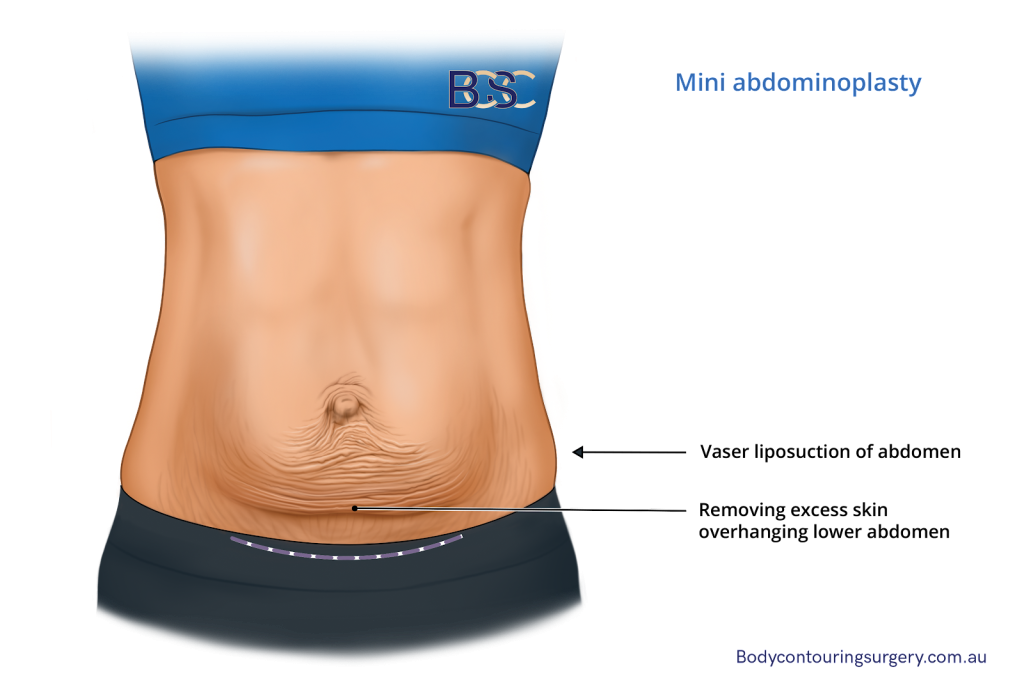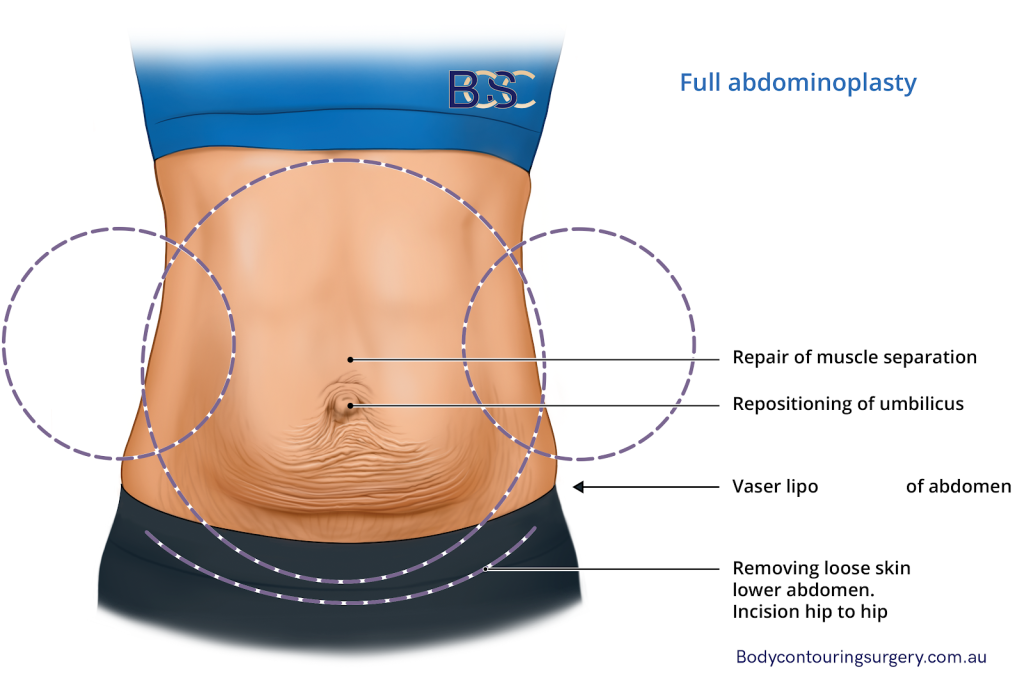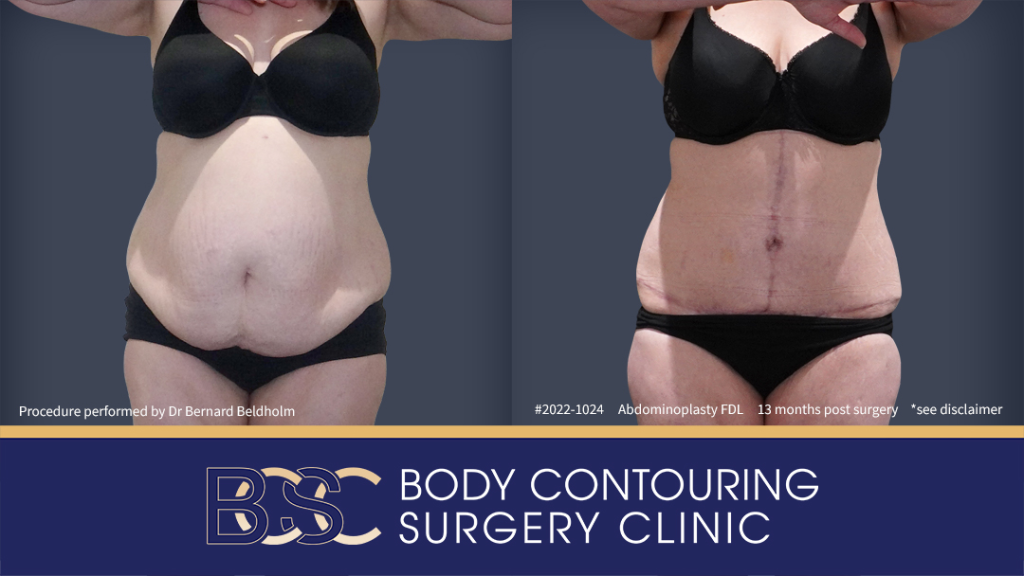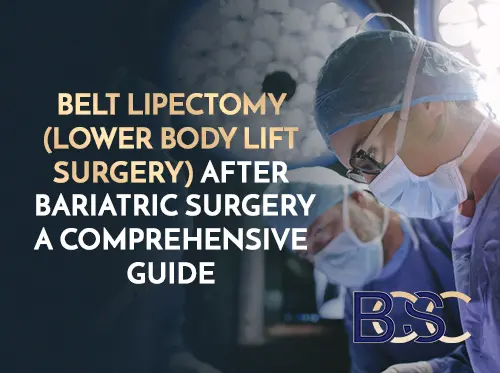How to Maintain Results Following Abdominoplasty
Maintaining the results of an abdominoplasty involves a combination of proper post-operative care, a healthy lifestyle, ongoing attention to an individual’s body, and a little patience.

Illustration of Mini Abdominoplasty
Tips for Maintaining Abdominoplasty Results
Maintaining the results of abdominoplasty involves combining proper post-operative care, lifestyle adjustments, and ongoing health habits. Some notable areas of concern include:
Tip#1: Following All Post-Operative Instructions
Patients should adhere to their surgeon’s post-operative instructions to achieve a successful recovery and obtain the best possible results. These instructions may include caring for wounds, following medication schedules, avoiding alcohol and smoking, limiting activities, and wearing compression garments.
Proper wound care involves keeping incisions clean and dry, changing dressings as directed, and avoiding strenuous activities. Taking medication as prescribed helps manage pain and prevent infections. Compression garments help support the abdomen, reduce swelling, and tighten skin. By diligently following these guidelines, an individual can promote healing and lower the chances of potential complications.
Tip#2: Attend Follow-Up Appointments
Patients should schedule regular check-up appointments with their medical practitioner to track their healing process and any arising issues. These appointments involve a thorough examination of the surgical site, assessment of recovery progress, and potential adjustments to the treatment plan.
Tip#3: Eat A Healthy, Well-Balanced Diet
Eating a balanced diet is essential for promoting healing, managing weight, and overall health. Patients should include a mix of fruits, vegetables, lean proteins, whole grains, and healthy fats in their meals. These types of food provide nutrients, oxidants, and protein necessary for tissue repair.
Patients should limit the consumption of sugary foods, processed items, and unhealthy fats, which can lead to weight gain and inflammation that may impede the healing process. A well-rounded diet helps with optimal healing, immune function, and overall well-being.
As per the findings by Aesthetic Surgery Journal suggest that “Protein plays an important role in fibroblast maturation, collagen production, and angiogenesis, all of which are critical for posttreatment wound healing. Pre-treatment protein supplementation can significantly reduce wound healing complications in a post-abdominoplasty patient. We observed no wound healing complications in the group prescribed protein supplementation.”
Tip#4: Stay Hydrated
It is vital to stay hydrated for good health, skin flexibility, and healing of wounds. Patients should drink enough water daily to keep their bodies hydrated and functioning well. Hydration plays a role in maintaining healthy skin, preventing dehydration-related issues, and aiding the body’s healing abilities. It’s advisable to take at least 8-10 glasses of water daily, depending on activity level and the weather conditions.
A study by Aesthetic Surgery Journal highlights the significance of post-operative hydration (DVT) in preventing deep venous thrombosis. “Hydration has been thought to play an important role in preventing DVT after surgical procedures. A low fluid volume state (dehydration) can lead to hemoconcentration and low venous flow.”
Tip#5: Exercise Regularly
Regular physical activity is crucial for overall health and recovery from surgery. It helps with muscle tone, circulation, and oxygen delivery to tissues. Before starting an exercise routine post-surgery, it is essential to consult with a specialist surgeon for personalised recommendations based on specific needs.
As patients recover, they should slowly introduce exercises that focus on strengthening their abdominal muscles and core, such as pelvic tilts, abdominal contractions, and leg lifts. Steer clear of vigorous activities or high-impact exercises that could strain the surgical site.
Adding flexibility and stretching exercises to the routine can help with recovery by enhancing the range of motion and preventing injuries during exercise. Additionally, paying attention to the body’s cues and not pushing too hard is crucial for maintaining a successful and long-lasting exercise routine while recovering.
Tip#6: Avoid Alcohol and Smoking
Smoking can negatively impact a patient’s skin’s healing process and condition. The substances found in cigarettes, such as nicotine, can hinder proper blood flow, slow down the healing of wounds, and heighten the chances of infections.
Alcohol on the other hand can disrupt the body’s ability to heal, lower immunity, and cause dehydration. Alcohol may also have harmful interactions with prescribed medications, potentially prolonging recovery time. Dr. Beldholm advises quitting smoking and alcohol at least six weeks before and after surgery.
Based on a recent study “Smoking is an independent risk factor for deep incisional surgical-site infection. Smoking can impair wound healing and increase the risk of postoperative complications, making it important for patients to take steps to reduce this risk before and after undergoing surgery.”
Tip#7: Maintain a Stable Weight
Weight changes can affect the outcomes of a patient’s abdominoplasty procedure. Individuals must keep their weight stable within a healthy range that suits their body type. To achieve this, patients should practice portion control and keep track of their calorie intake.
Sudden fluctuations in weight can impact how an individual’s body looks and may affect the success of their surgery.
Tip#8: Protect Skin from Sun Exposure
It is essential to shield the skin from sunlight after an abdominoplasty. Proper sun protection is crucial for preserving skin health and appearance, especially on the surgical site. When choosing a sunscreen, opt for a broad-spectrum sunscreen with an SFP of 30 or higher. Apply sunscreen generously on the surgical site at least 15-30 minutes before going out in the sun.
Tip#9: Deal with Any Issues Promptly
It is crucial to promptly treat any post-operative issues following abdominoplasty to ensure a smooth recovery and optimal outcomes. Patients should contact their medical practitioners immediately if they notice any problems after surgery, like ongoing swelling, unusual changes in their stomach, or signs of infection.
Seeking prompt medical attention can help prevent problems, aid healing, and ensure the best possible results.
Tip#10: Be Patient
It is essential to realise that healing is a gradual process and may take time to manifest fully. Patients should avoid pushing themselves too hard or expecting instant results.
Individuals should be patient with themselves, acknowledge small achievements, and concentrate on steadily progressing toward their goals.

Illustration of Full abdominoplasty
Full, Extended, or Fleur-de-lis Abdominoplasty?
In addition to the above recommendations, individuals who have undergone a full or Extended tummy tuck (Abdominoplasty) or Fleur-de-Lis Abdominoplasty may need to take additional precautions to maintain their results due to the more extensive nature of the procedure.
Here are some additional tips:
Scar Care
Taking care of scars following a full abdominoplasty is essential, as the procedure involves larger incisions. Patients should follow their surgeons’ guidelines for scar care, which may include using silicone sheets or gels to flatten and soften scars. Massaging the wounds with a moisturising cream or oil can also help blood flow and break down scar tissue.
Dr. Beldholm notes the following. “Properly caring for scars is essential for achieving the best outcomes following an abdominoplasty procedure. By using individualised techniques for managing scars, individuals can improve the healing process and reduce the scar appearance.”
Drain Care
During abdominoplasty surgery, drain tubes are commonly placed to extract excess fluid, blood, and tissue debris from the surgical area. These drains help prevent fluid build-up, lower the chances of seroma development, and aid in proper wound healing.
Proper drain care is crucial for successful recovery after surgery and requires the patient to comply with medical instructions.
Massage Therapy
Integrating massage therapy into recovery after surgery can offer various advantages, like promoting lymphatic drainage to decrease swelling and improve circulation in the surgical site. Massaging scar tissue can help diminish collagen fibres, soften scars, and improve their look with time. Additionally, receiving massages can induce relaxation, lessen muscle tension, and relieve discomfort or tightness in the abdominal area.
Based on a study by Sage Journals, “Receiving Lymphatic drainage massage after abdominoplasty caused a greater reduction in oedema than standard compression garments alone. The lymphatic drain is performed using a technique known as the Vodder Method, which uses circular movement with increases and decreases of pressure on the treated area. The changes in the pressure generate a pumping effect, which encourages lymph movement throughout the tissue.”
Maintain Good Posture
Maintaining good posture is crucial for supporting the outcome of abdominoplasty and preventing stress on the surgical site. Tips for proper posture include standing tall with shoulders, back, and spine straight, and engaging the abdomen to support core muscles.
Patients should avoid slouching by sitting or standing with their backs against a chair or wall instead of hunching forward. Utilise ergonomic support like chairs, pillows, or lumbar rolls to ensure proper spinal alignment and lessen the strain on the back and abdomen.
What to Consider Before Abdominoplasty For Smooth Post-Surgery Results

Fleur de lis abdominoplasty Before & After
Disclaimer: Operation performed by Dr Bernard Beldholm. Adult content, surgery has risks; individual results vary, seek 2nd opinion. Please see the full disclaimer.
Before having surgery, you should carefully consider whether or not you need to:
- Take time off work.
- Have someone drive you home after surgery
- Rest for an extended period. (eg. lying down or sitting with your leg elevated)
- Organise help around the house while you rest
- Prepare meals in advance. This prevents long periods of standing
- Have pain relief. (Panadol™/Avoid Aspirin and Anti-inflammatory Drugs)
- Return to the Clinic for dressing changes or wound inspections if directed, otherwise, purchase enough dressings to change at home
FAQs
Here are some frequently asked questions following abdominoplasty surgery.
How painful is abdominoplasty?
During the initial weeks following the treatment, you should feel moderate and severe pain and discomfort, especially in your abdominals. However, the pain gradually reduces as you heal.
When is it too late to massage scar tissue?
Usually, scar massages are recommended for two to three weeks of treatment after surgery. The maturation process can take six months to 5 years after surgery. During the initial healing stage, it is important to protect the wounds and prevent infections. Scar massage is usually no longer effective once the scar tissue is fully mature which is usually around one to two years after surgery.
How long will I have to remain in the hospital after tummy tuck (Abdominoplasty)?
It is recommended to remain in the hospital for at least one night after tummy tuck (Abdominoplasty) procedure. However, the duration may vary depending on individual factors such as type of surgery and overall health condition.
References
- Austin, R. E., Lista, F., Khan, A., & Ahmad, J. (2015). The impact of protein nutritional supplementation for massive weight loss patients undergoing abdominoplasty. Aesthetic Surgery Journal, 36(2), 204–210.
- Keiter, J. E., Johns, D., & Rockwell, W. B. (2015). Importance of Postoperative Hydration and Lower Extremity Elevation in Preventing Deep Venous Thrombosis in Full Abdominoplasty: A Report on 450 Consecutive Cases Over a 37-Year Period. Aesthetic Surgery Journal, 35(7), 839-841.
- Toyoda, Y., Fu, R. H., Li, L., Otterburn, D. M., & Rohde, C. (2018). Smoking as an Independent Risk Factor for Postoperative Complications in Plastic Surgical Procedures: A Propensity Score–Matched Analysis of 36,454 Patients from the NSQIP Database from 2005 to 2014. Plastic and Reconstructive Surgery, 141(1), 226–236.
- Presman, B., Finnerup, K., Andresen, S. R., Nikolajsen, L., & Finnerup, N. B. (2015). Persistent Pain and Sensory Abnormalities after Abdominoplasty. Plastic and Reconstructive Surgery – Global Open, 3(11), e561.
- Regan, J., & Casaubon, J. T. (2023, July 24). Abdominoplasty. StatPearls – NCBI Bookshelf.
- Vidal, P., Berner, J. E., & Will, P. A. (2017). Managing Complications in Abdominoplasty: A Literature Review. Archives of Plastic Surgery, 44(5), 457-468.
- Maningas, T., Sturm, L., Mangler, A., & Pazdernik, V. K. (2019). Manual Lymphatic Drainage in Postoperative Abdominoplasty With Core Liposuction Patients. The American Journal of Cosmetic Surgery.
- De Paep, K., Van Campenhout, I., Van Cauwenberge, S., & Dillemans, B. (2021). Post-bariatric abdominoplasty: identification of risk factors for complications. Obesity Surgery, 31(7), 3203–3209.
- Mazzocchi, M., Dessy, L. A., Di Ronza, S., Iodice, P., Saggini, R., & Scuderi, N. (2012). A study of postural changes after abdominal rectus plication abdominoplasty. Hernia, 18(4), 473–480.
- De Lourdes Nahhas Rodacki, C., Rodacki, A. L. F., Ugrinowitsch, C., Zielinski, D., & Da Costa, R. B. (2008). Spinal unloading after abdominal exercises. Clinical Biomechanics, 23(1), 8–14.
- Soteropulos, C. E., Edinger, K. M., Leibl, K. E., & Siebert, J. W. (2020). Improvement in Back Pain Following Abdominoplasty: Results of a 10-Year, Single-Surgeon Series. Aesthetic Surgery Journal, 40(12), 1309-1315.
